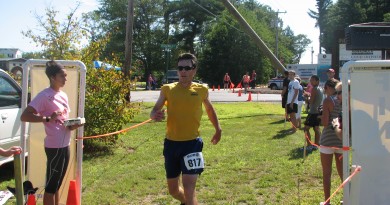How To Get Fitter, Faster
Covid-19 took a measureable toll on our waistlines this past year. Here’s how to get back on track.
This new year holds a different meaning than in Januaries past. Often a time of reflection, looking back at the highs and lows of the previous year typically helps shape our goals for the future as we look optimistically towards what lies ahead.
That was until the absolute dumpster fire that was 2020.
It likely won’t come as a big shock that a global survey found what so many of us have experienced firsthand: the coronavirus pandemic has wreaked serious havoc on our physical health.
Worldwide, people are exercising less, eating more unhealthy foods and seeing the results of that on their scale. Jokes about the “quarantine 15” or “COVID-19” weight gain are rooted in reality as the motivation to move our bodies and eat well have waned and the pounds have piled on. A Weight Watchers survey found that individuals gained an average of 12.5 pounds between March and June and it is likely this number has only increased as the months of living in various degrees of lockdown have continued.
I witnessed this firsthand. Like many back in March, I transitioned from commuting to work every day where I would exchange casual hellos, hand-shakes and even (gasp) hugs with others to working from home and communicating entirely through a computer screen. In meeting with nutrition clients virtually, I spoke regularly with individuals feeling defeated by undesired weight gains. With routines completely disrupted and stress at an all-time high, their eating and exercise habits drastically changed.
Take Carol, a longtime client I worked with who had been consistently losing weight prior to the pandemic. Preparing meals from scratch, packing healthy lunches for work and diligently following a training plan for an upcoming half-marathon were just some of the things that had been allowing Carol to succeed in her weight loss goals. You can probably see where this is headed.
The pandemic and ensuing lockdown left Carol scrambling to adjust to a new schedule and seriously stressed. Her new “home office” was located at the kitchen table and food became a source of comfort. With the refrigerator and pantry just steps away, she found herself mindlessly grazing during the work day on the crackers, chips and baked goods she stocked for her kids. Dinner became takeout and, after the kids went to bed, a pint of Ben and Jerry’s was the only thing that seem to help her feel better even if just fleetingly.
Numerous studies back up this psychological drive to overeat when stress levels rise. As for those training runs? Her upcoming half-marathon was postponed indefinitely, leaving her unmotivated for daily runs.
As she lamented how difficult it was to see the results of her hard work slip away, she, like many others, struggled with how to break out of this pit of despair as the stress of gaining weight only compounded the anxiety she felt from everything else going on in the world.
I heard very similar accounts in Zoom after Zoom call. However, I began to notice an interesting dichotomy. While many of us like Carol found that our extra time at home was spent completing puzzles, making sourdough starter and binge-watching Tiger King (what were we thinking?!) others saw it as an opportunity to emerge from quarantine life stronger, fitter and generally healthier than ever before.
For that small minority, the new “normal” was finally time to dedicate themselves to health in a way that had previously eluded them. What so many viewed as negatives to pandemic life were reframed into positives. Working from home meant no more commute to work allowing for time in the morning to cook a healthy breakfast. Social distancing may have made gathering with friends for a drink after work taboo, but a solo evening bike ride with water as the beverage of choice? Even better.
An abrupt and forced change to our way of life was not something to be met with resistance and contempt, but embraced as the opportunity to finally do the things that for too long we just didn’t have time for.
And that right there is the key. Perception is reality. If we see barriers and lack the self-efficacy or motivation to overcome those barriers then positive change is all but impossible to achieve. But what if we reframe those barriers and find the hidden opportunities to exact positive change in ourselves? Now we’re talking a recipe for success.
Of course, easier said than done. For the most part, we know what we should and shouldn’t do when it comes to diet and exercise. Finding the motivation to make the healthy choices day in and day out is hard even in the best of times. Doing so during a pandemic? Yikes. Fortunately, you don’t have to blindly search for some hidden source of motivation that constantly eludes us the moment we have to decide between another night of ordering a pizza or preparing a healthy meal from scratch. Here’s how:
Set SMART goals. SMART is an acronym that stands for specific, measurable, achievable, relevant and time-based. This framework is designed to help you clarify what your want, focus your efforts and increase your chances of success. Here’s what should be addressed for each:
Specific: Identify what you would like to accomplish and why it’s important to you. Measurable – make your goal more tangible by defining the metrics that you will use to gage your progress. Achievable: Ensure your goal is realistic and attainable to increase your odds of success. It’s important to push yourself, but not to aim so high that you get discouraged when your goal proves to be too far out of reach.
Relevant: consider how much your goal matters to you and whether it aligns with your values.
Time-based: set target dates for when you will accomplish your goal. If you are identifying a long-term goal, set some smaller progress goals that work toward getting you there.
Hold yourself accountable. Once you’ve established your goals, the key to seeing them through is accountability. Enlist a friend or family member to help by letting them in on your goals. Even if they can’t physically be with you, the social support and just knowing someone else is aware of your goals can help keep you on track. If you prefer to play things close to the chest then consider strategies to be accountable to yourself. The best way to go: a food journal.
A 2019 study found that subjects who spent just 15-minutes or less per day logging their food intake lost more weight than those who didn’t consistently track. Seeing as these days we have plenty of extra time on our hands, spending less than 15-minutes a day to note what we’ve consumed isn’t a big ask. Whether you prefer an app such as MyFitnessPal, Excel sheet or a hand-written journal, the key is being honest and consistent. Think of these as the Strava or FitBit for your diet.
Be kind to yourself. We tend to beat ourselves up, especially when it comes to eating and exercise habits. Everyone has an off day or two. Throwing in the towel simply because you skipped a workout can be tempting as you start to question your ability to follow through on your goals. Instead of seeing these missteps as failures, take a step back and recognize all of the good things you are doing. Making healthy choices is challenging so hit reset and refocus on why your goals matter.
3 APPS FOR YOUR APPETITE
This is a new year and although our circumstances may not have changed as much as we would like and a lot of uncertainty remains, there is still plenty of opportunity ahead. We can learn a lot from the past year. Particularly from examining both those who have faltered in their health habits and those who have thrived. Understanding what separates the two just may be the key to making 2021 your healthiest year yet.
FitBits, Strava, Zwift: Technology has helped us track how much we exercise, where we go, for how long and for how fast. And if there were an app that could miraculously help you lose weight, someone would be very, very rich. Well, the following three apps take different approaches to helping by making you more aware of the foods you are eating and their nutritional values. Here are the pros and cons.
LoseIt: With challenges you can join (e.g. log your food every day for a year; lose 10 lbs in ten weeks, etc.) as well as all the calorie and fitness tracking most apps offer, and pop-up tips about the foods you add, LoseIt has become one of the most popular apps, especially for anyone who is competitive and an athletes. It can connect to FitBits, Apple watches and more and the app even has fitness guides and nutrition plans. It has a bar code scanner so you can scan foods at the store and a Snap It feature which allows you to take a photo of your meal (though analyzing portion sizes is a challenge.) The basic app is free but you’ll get endless prompts to upgrade to a yearly plan ($39.99) for personalized fitness plans and other bells and whistles. Go ahead, if you are serious about dieting, it’s worth it.
MyFitnessPal: This is a simple, straightforward app owned by Under Armour that you can use to track your food intake, nutrients, exercise and more. What we like about it is that it has a vast database of foods (if candied walnuts are your thing, you can pick from multiple brands) and is easy to use. It also prompts you to drink water and log your exercise and it calculates total nutrients. If you’re going Keto, it can track carbs –but you will also see how much sodium you are consuming. And, like many apps, it has a social media connection and a community you can join to help you maintain your goals and get social support. And its basic functions are free.
NOOM: Unlike many weight loss apps, Noom goes beyond just tracking calories in versus calories out, emphasizing a behavioral component that has users dig into the “why” and “how” of their weight loss goal. The app provides daily tasks to facilitate this, often short articles to read or quizzes that can be done throughout the day. Nutrition is still a top priority with a user-friendly color-coding system that rates foods as green, yellow or red based on the nutritional value of each food and how often you should eat it. Similar to other weight loss apps, Noom entails daily food logging and weigh ins to monitor progress and increase accountability. The cost is $150 for a six-month subscription, which is a small price to pay for meaningful lifestyle change that provides lasting weight loss.



